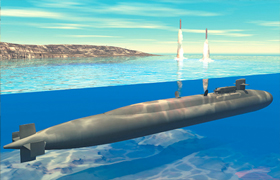
The world’s deadliest weapons are also the stealthiest.
The United States, Russia, China, Britain, and France all have fleets of submarines that carry nuclear missiles. The most advanced of these subs are nearly undetectable and can stay submerged for months.
A U.S. Trident nuclear submarine carries 24 missiles, each fitted with several independently targeted warheads. One of these subs carries enough explosive power to destroy every major metropolitan area in the Northern Hemisphere, according to the Federation of American Scientists.
Today, the U.S. is by far the leader in sub-launched missile technology. But other nations, especially China and Russia, are trying to narrow the gap.
Tracking each other’s submarines was a major headache for the U.S. and the Soviet Union during the Cold War. Salt water is mostly opaque to electromagnetic radiation, so subs are invisible to radar. Sonar can locate underwater objects, but modern submarines are built to be very quiet.
Professor Alex Kaplan is a Whiting School physicist and engineer who has received a number of the Air Force Office of Scientific Research’s so-called “6.1” grants aimed at developing new technologies over a period of decades rather than years.
One of his areas of research is all forms of waves, from waves in exotic objects like “quantum carpets” of photons to the more ordinary sort that slosh around the ocean.
Ocean waves may look uniform, Kaplan says, but they are not. They are subject to subtle changes in their shape because of shifts in the environment beneath. These shifts could include the movement of the Earth’s crust in an earthquake or the passing of a nuclear submarine.
By taking baseline satellite measurements of ocean waves at their minimum and maximum points in the slope or “gradient,” he says, and watching these parameters change, you might be able to see what’s happening beneath them.
He published a paper in the October edition of Physical Review Letters on the “gradient markers” on waves that might be tracked as part of a new form of sensing technology. The work is so far theoretical, and any practical application could face the challenge of distinguishing between the signal from the gradient markers and the “noise” of currents and eddies in the water.
“You know, the waves are never clean stuff. There are currents, ripples,” he says. Teasing the data out of the noise, he admits, could prove impossible. But Kaplan, a graduate of the legendary Moscow Institute of Physics and Technology who came to Hopkins in 1987, says he has tried throughout his career “to look beyond the horizon.”
“You want to do a real exciting thing? Think of where the whole field is going.”




